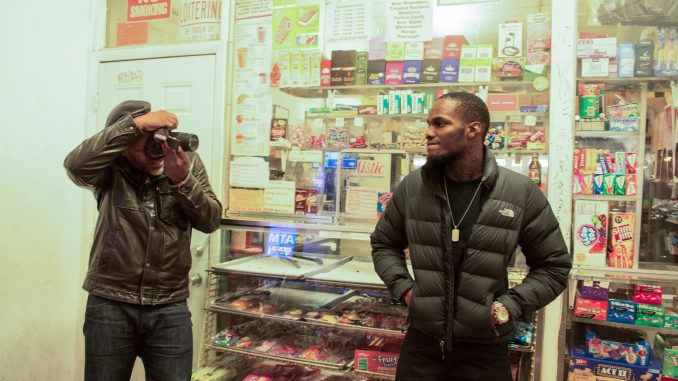
The sun is going to set in 15 minutes,” said alumnus and street photographer Shawn Theodore.
“Too soon.”
He sped down Girard Avenue, a camera in his BMW—his latest effort to salvage the fading rays of sunlight he uses to illuminate his photographs.
“I love natural light, I love shadow and color,” Theodore said. “Those are my things. And, you know, people, too. You’ve got to have people.”
He shoots his subjects discreetly at first, an attempt to preserve the candidness of the image. Then, he starts a conversation.
Walking into a corner store on Diamond near 16th, Theodore stopped a resident, complimented his salmon-colored sneakers, and casually began shooting.
“So yeah, I’m a photographer. I don’t mean to just come at you, bro,” Theodore told the man.
Plastered onto the pages of Ebony and Complex, and cast as a featured photographer by Instagram and The New Yorker, Theodore’s photography of urban black neighborhoods has gained recognition within the past year.
Recently, Theodore photographed Philadelphia Orchestra’s assistant principal bassist Joseph Conyers against the backdrop of a graffitied building on American Street for JUMP magazine. JUMP’s photo editor, Mike Bucher, said he immediately noticed Theodore’s friendly interaction with his subjects.
“He immediately gets [Conyers] real comfortable and has a few things already planned, where he wants to go,” Bucher said. “Just like little, little corners or nooks of the building.”
This month at the Painted Bride Art Center, Theodore’s solo show “The Avenues” will display photographs taken on iconic Philadelphia roads, like Diamond Street and Ridge Avenue.
“You find yourself wondering, ‘Oh man, what was this like when it was in the ‘70s or whatever,’” Theodore said. “That kind of thing is what got me shooting.”
His work often includes shots of pedestrians who clash against luminous backgrounds—a pale lavender brick wall or a shadowy earth-colored garage door.
Theodore observes neighborhoods, sometimes for months, before beginning to shoot. Recently, he studied the Frankford section of Northeast Philadelphia.
“It’s not as friendly as the rest of Philadelphia,” he said. “As I say, it’s true Philadelphia … and I love it.”
Theodore rarely shoots a setting that has been engulfed by what he refers to as “hipster life”—unless gentrification is part of the story.
Often, it is.
“You know, if you find a 90-year-old woman walking by a modern Lego-house, there’s some juxtaposition there that you can express visually,” Theodore said.
Although a proud Temple alumnus, he doesn’t hesitate to rebuke the university’s interaction with the community that surrounds it.
Theodore said North Philadelphia has become almost extinct.
“If you don’t have a school to send your kids to, why live in the neighborhood?” Theodore said. “It’s a really weird cycle. And that’s the thing that I’m trying to capture. This mood of the cycle.”
The scope of Theodore’s lens is national—he began his photography career snapping photos in Brooklyn, and has explored cities like Camden, New Jersey and Baltimore, Maryland— but his Olney roots and familiarity with Philadelphia shine in his local work.
After graduating from Parkway Program High School, Theodore enrolled at the Tyler School of Art. Craving a business savvy profession and guided by a love of writing, he switched to study a major Temple used to offer: a combination of journalism, public relations and advertising.
The day his classmates walked at graduation, the alumnus walked into an interview that landed him his first job out of college.
“That was part of my pitch,” Theodore said. “I was like, ‘I could be at my graduation, walking, but I’m here’, and that actually got people’s attention.”
Photojournalism wasn’t part of Theodore’s career until long after he graduated; he worked instead in public relations, crafting companies with colleagues.
Lacking a single photography class, he rode a bike through North Philadelphia, shooting and uploading images of “chop shops”—spaces where vendors sell stolen cars and car parts.
The first of Theodore’s Philadelphian photos were met with shock, fear and confusion from family members. But he viewed his early work as pure journalism.
“There was no intent of malice on my part,” Theodore said. “I just wanted to show, this is the side of Philly you’re never going to really see. Or come in contact with these people. Let’s look at their lives, and see what they do.”
Angela Gervasi can be reached at angela.gervasi@temple.edu.


Be the first to comment